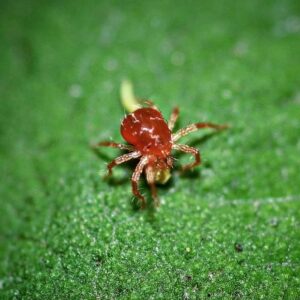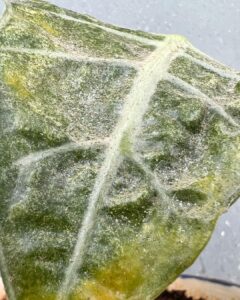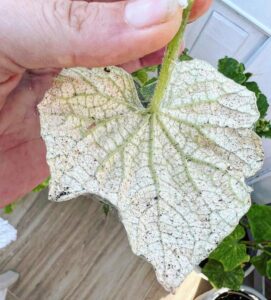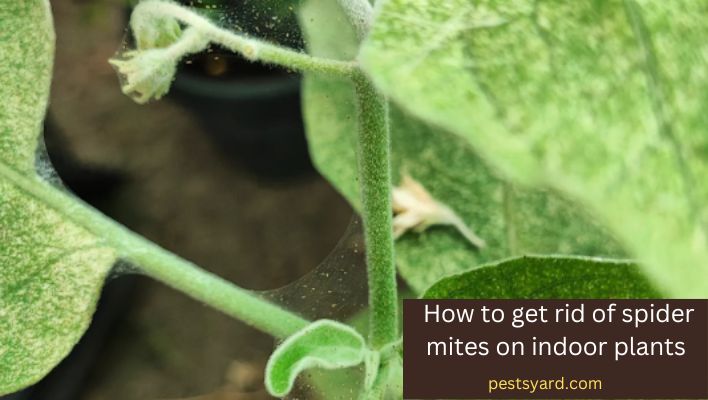A plant is a beautiful ambiance to the indoor area that improves air quality and reduces stress. However, sometimes indoor plants are so much more than we can handle. Plants can suffer from several disorders, including spider mites, thrips, and powdery mildew. In this post, I will give you some tips on how to get rid of spider mites on indoor plants.
Spider mites are a common problem in the home that affects indoor plants. They suck the sap of your plants, causing them to wilt and die when ignored. These mites multiply quickly and will infest your plants within a short period.
There are numerous ways to eliminate spider mites on your indoor plants without harsh chemicals or expensive products. That’s why we’ve put together this quick guide to getting rid of spider mites naturally. However, you need to know the cause of infestation to prevent future occurrences.

Where do spider mites come from on indoor plants
Spider mites are microscopic arthropods found on most indoor and outdoor plants. They are typically about 1mm long and thrive in warm, humid environments. Spider mites are most common during the summer but are also occasionally seen in winter.
They can be a major problem for indoor plants because they feed off of plant sap, resulting in damaged leaves and leaves with deformed edges. Spider mites come from outside and can be found in warm, dry climates.
The most common cause of spider mite infestations on indoor plants is overwatering of plants. They’re not just a problem for indoor plants; they’re a problem for all gardeners. They can be anywhere: in your house, on your lawn, or even on your skin.
They’re usually found near the soil line where they can find their food. These can get on indoor plants by traveling on wind, water, or transported by insects.
Spider mites usually first appear when a plant is stressed or over-watered. They need humidity and moisture to survive, so if you’re having problems with spider mites, it’s important to make sure your plants have enough water and that no excess soil or dirt is clogging up their roots.
Spider mites thrive in warm, humid environments, and overwatering can lead to an outbreak. In addition, if your indoor plants are not properly cared for, you may have a greater chance of having a spider mite infestation.
Early signs of spider mites on houseplants
Spider mites are a common and destructive pest in the home. They are tiny insects that feed on plants. They are so small that they can be difficult to spot, but their presence is often obvious when you see webbing on your plants or yellow spots on your leaves.

Spider mites cause damage by sucking plant juices and destroying plant cells. They can also cause allergic reactions in some people, so it’s important to check for signs of spider mites before bringing home a new plant.
Spider mites have an uncanny way of appearing as soon as you stop caring for your plants—they’ll appear when the plant is in bloom or just after a frosty night.
If you notice brown spots or holes in your indoor plants’ leaves, it could signify spider mites infestation. You might also notice that the leaves appear yellow, wilted, or even blackened around the edges. These symptoms indicate a severe infestation.
The symptoms associated with spider mite infestations are similar to those of other fungal diseases: the leaves of your plant will yellow, curl up, and die back. Some plants may also develop holes in their leaves (although this is less common).
If you suspect spider mites on your houseplant, here are some tips for finding them:
- Look for small spots where leaves look yellow or brown instead of green: These are probably already infested with spider mites.
- Look for webs: Spider mites make tight webs to keep other insects out of their webs, but you can sometimes see them if it’s been a while since you last sprayed your plant with insecticide. Look for webbing between leaves or under the plant’s soil surface.
- Check the undersides of leaves: If you see these dark spots, chances are good that those spots are infested with spider mites too.
- PEST DEFENSE - Insecticidal Soap controls adelgids, aphids, lacebugs, mealybugs, mites, tent caterpillars, grasshoppers, thrips, scale, & more.
- INDOOR & OUTDOOR USE - Designed for use indoors, outdoors, & in greenhouses on fruit & nut trees, corn, soybeans, melons, peas, cabbage, figs, grapes, citrus, houseplants, ornamentals, & more.
- CONTACT SPRAY - This product is a contact spray. Pests must be sprayed directly to achieve control.
How to get rid of spider mites on indoor plants naturally
Neem Oil
Neem oil is a great way to kill spider mites on indoor plants. It is a natural pesticide and insecticide extracted neem tree. It’s often used as an insecticide and pesticide to control mosquito populations, and it can also be used to get rid of spider mites on indoor plants. It is a very effective pesticide and should be used as soon as you notice spider mite infestation on your indoor plants.
To make neem oil spray, mix 1 cup of water with three tablespoons of neem oil and ½ teaspoon of lemon juice. Mix well and then pour into a bottle or container. You can spray this mixture onto indoor plants every day for several weeks until there are no more signs of spider mites.
Neem oil works best with other treatments like cedar chips or horticultural oils. It’s important not to use neem oil on outdoor plants because it can cause damage to your plants’ health over time.
Horticultural Oil Spray
Horticultural oil spray is another great way to eliminate spider mites on indoor plants naturally. It’s made from plant-based oils and will kill any spider mites on your plants’ leaves, stems, and buds.
All you need to do is spray the affected areas with the oil mixture. You can also use it as a preventative measure by spraying it on your plants before they get infested with spider mites.
Horticultural oil spray can be purchased at most garden stores, or you can make it yourself by mixing 1 tbsp petroleum jelly with 1 tsp vegetable oil until you get an emulsified mixture. Smear this mixture onto the affected areas of your plants and leave for about 20 minutes before washing off with water.
Alcohol Spray
Alcohol spray is the best way to get rid of spider mites on indoor plants. Not only does it kill them, but it also helps prevent future infestations by drying out their eggs and destroying their life cycle.
To use alcohol spray on your indoor plants, spray the leaves with alcohol. You can do this in the morning or at night, depending on your available time. Spray all sides of the leaves and let the plant dry out before watering it again.
The spray should be applied once or twice weekly, starting in early spring and continuing through summer. It’s best to apply it when the plants are dry and then wait for about 10 minutes before watering your plants again.
You should also make sure to change your irrigation system every three months to prevent any buildup from building up in your pipes or sprinklers.
Diatomaceous Earth
Diatomaceous earth is a naturally occurring sedimentary material that is made up of tiny fossilized shells created by diatoms, a type of algae. It’s also known as Kieselguhr and has been used for centuries to kill insects on farm animals, but it can also be used to treat plants with spider mites.
- Mix one part diatomaceous earth with four parts water and apply directly to the leaves of your indoor plants. This can be done in the early morning or at night before you go to bed. Make sure you cover all visible areas of the plant with Diatomaceous Earth!
- Leave this mixture for about two days, remove it from your plant, and wash off any residue with a mild soap solution (like dish soap).
- Repeat this process every two weeks until you see no more signs of spider mites on your plants!
Cayenne Pepper Spray
There are a few different options if you want to get rid of spider mites on your indoor plants naturally. Cayenne pepper spray is one of those effective options. This spray is made from cayenne peppers, which have been used for centuries as natural pesticides. They’re not just for humans—they can also be used to kill off pests like spiders and caterpillars in your garden!
To use cayenne pepper spray, mix two tablespoons of cayenne pepper into a quart of water. Then, fill the rest of the bottle with water and shake it up well to mix everything.
You’ll want to use this spray daily until you finish eradicating all traces of spider mites from your indoor plants. You can also use this method to treat other pests such as aphids, mealy bugs,, and caterpillars.
Using Epsom salt
Epsom is a natural and inexpensive way to treat indoor plants with spider mites. Epsom salt has great anti-fungal properties, which means it will help stop the growth of mold and bacteria that spider mites produce when they feed on the plant’s leaves.
It also acts as a fungicide, preventing fungal diseases from spreading to other plants in your garden or backyard. And because it’s so cheap, it’s great for any gardener who wants to save money while maintaining their green thumb!
It is a good way to catch spider mites early on to treat your plants before they multiply too much and cause real damage. It’s also safe for humans and pets, so you don’t have to worry about negative side effects.
You can use Epsom salt in several different ways:
- To sprinkle around plants (especially when exposed to the sun). This helps kill off any eggs or newly-hatched spider mites that may have been hiding out underneath the leaves of your plant during the day.
- Mix 1 cup of Epsom salt into 1gallons of water. Soak your plants in this solution for 3-5 minutes, then rinse off with soapy water and remove all of the salt from the leaves.
Use Dish soap solution.
One of the easiest ways to get rid of spider mites is using a dish soap solution. You can make your solution by mixing a few drops of dish soap with water, or you can buy a bottle from the store. Just make sure that it’s made for plants.
When making the solution, pour some into a spray bottle and spray your plant leaves or stems. If you want to use it inside your house, mist it onto the affected area of the plant. This should be enough to eliminate any spider mites on your indoor plants.
What you need:
- 1 cup of dish soap (You can use a non-detergent soap if you prefer)
- 1 quart of water
The Procedure:
- Pour the dish soap solution into a spray bottle and add water until it’s 1 quart. This will make a diluted solution that will work on most indoor plants.
- Wash the plant with the diluted dish soap solution, let it sit for at least 30 minutes, then rinse thoroughly with clean water. Make sure to scrub off any dead leaves or debris from your plant before applying this treatment, as it can be harsh on leaves.
Baking Soda
You’re probably sick of battling spider mites if you’ve got indoor plants. But here’s a fun trick for getting rid of them: mix 1/4 cup baking soda with enough water to make it a paste, and apply it to the leaves of your plants.
You can also sprinkle some baking soda around the base of the plant and let it sit for a few days. This will help dry out the spider mites and make them easier to kill by spraying them with water or insecticidal soap. The baking soda will kill the mites on contact, and you won’t have to worry about them returning.
Use Bleach
Bleach is a homemade cleaner that contains acid, and it is a popular and natural way to eliminate spider mites on indoor plants. Make sure to dilute it with water, so the mixture is less concentrated. Then mix the solution with warm water and spray it onto your plant leaves. Do this every two weeks until you no longer see any spider mites on your plants.

Use Garlic Spray
Garlic spray is a natural remedy used for centuries to treat plant diseases like spider mites. This spray eliminate fungal and insect pests like spider mites without using harsh chemicals or pesticides that can harm humans or pets.
Garlic has natural oils that repel the mites and make them leave your plants alone. You can find garlic spray at most grocery stores, and it’s a great way to quickly treat your plants while they’re still in their growth stage.
If you’re looking for a more convenient option, try making your own garlic spray using crushed garlic and water. Just place 1 clove of garlic in a bowl and mash it up until it’s well-crushed. Add 2 cups of water and let sit overnight in the refrigerator. Strain out the solids and use them as needed.
You can use garlic spray to eliminate spider mites and other pests. The spray will kill both mites and aphids and is safe for use around pets and children.
Garlic sprays are also easy and quick to use, making them ideal for small spaces like apartments or gardens where you don’t have much space for traditional pest control methods.
Use witch hazel
If you want to rid your indoor plants of spider mites, you may have tried different methods, and nothing seems to work. But the best way to eliminate spider mites on indoor plants is with witch hazel.
Witch hazel is a natural antiseptic and astringent used for centuries in folk medicine and modern medicine. It’s also very effective at killing spider mites and other common pests.
For easy application, you can make a spray with witch hazel and use it as needed to kill off any remaining mites. You can also use it to treat infected areas on your plants by soaking them with this solution for 20 minutes before watering them again.
Use Vinegar
Vinegar is an excellent way to get rid of spider mites on indoor plants. It’s a natural solution that won’t harm your plants and is simple to use.
Remember that the first time you use vinegar on indoor plants, you may see some damage to your plant. That’s normal—the acid is killing off the spider mites in the vinegar, and they leave behind some of their bodies in the soil. You’ll also see a lot of egg cases (little capsules that contain an egg) in your soil as well.
To use vinegar, mix 1 part vinegar with two parts water, and pour this solution over your indoor plants once or two until you no longer see any sign of infestation (usually within a week or two). You can also try mixing 1 part vinegar with four parts water and spraying this solution directly onto the leaves of your indoor plants. Be sure not to spray this mixture too close to the roots or stems of your plants because this could damage them—and could also harm you if you accidentally get some of it on yourself!
After using vinegar, it’s recommended that you mix up some baking soda and water together in a spray bottle and spray it directly on the plant itself. This will help suffocate any remaining spider mites once and for all.
Use Peppermint oil
Peppermint oil is another great way to eliminate spider mites on indoor plants naturally. The best part about peppermint oil is that it’s all-natural, so you can use it without worrying about harmful side effects.
The process for using peppermint oil to kill spider mites is simple: add a few drops of the oil directly onto your plant leaves. You can also rub some on the plant’s stem or pour a few drops into a spray bottle, mix with water, and spray directly onto the underside of the leaves.
How to prevent spider mites on indoor plants
A common problem for indoor gardeners is spider mites, which can be found on almost any plant in the house. They’re a little hard to see, but their presence is easily detected by sticky webs that appear when they feed on their host plants.
It’s important to know how to prevent spider mites and otehr pests on indoor plants to keep your plants healthy.
- Don’t overwater your plants—they need regular misting, not soaking. If you’re unsure whether your plant is getting enough water, check the soil near the base of the plant for moisture—if there’s none, then it needs more.
- Be sure that all of your potting soil is free from pests and disease before adding it to your planter or window box! You can buy pre-treated potting soil at most garden centers or online. Use gloves when handling soiled pots; remove any visible pests or debris with a soft brush before putting them back into storage.
- Use floating row covers over your indoor plants during the winter to protect them from cold weather damage caused by mites and aphids (the latter will cause leaf loss).
- Clean the plant’s soil with a mild soap and water solution every two weeks. Make sure you’re using plant-friendly soap and water, as some soaps are toxic to plants.
- Keep the air around your plants clean by removing any fallen leaves or pet hair from around them.
- Clean all surfaces that could be harboring spider mites, including windowsills, floors, walls, furniture, and pets (if applicable). You can use a vacuum cleaner with an extension tube for this purpose or use a hand broom dipped in a solution of vinegar and water.
- Use a good pesticide spray such as neem oil on affected areas of your garden regularly (once or twice a week). This will kill and prevent them from coming back.

